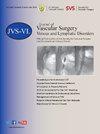An artificial intelligence interpretable tool to predict risk of deep vein thrombosis after endovenous thermal ablation
IF 2.8
2区 医学
Q2 PERIPHERAL VASCULAR DISEASE
Journal of vascular surgery. Venous and lymphatic disorders
Pub Date : 2025-04-30
DOI:10.1016/j.jvsv.2025.102253
引用次数: 0
Abstract
Objective
Endovenous thermal ablation (EVTA) stands as one of the primary treatments for superficial venous insufficiency. Concern exists about the potential for thromboembolic complications following this procedure. Although rare, those complications can be severe, necessitating early identification of patients prone to increased thrombotic risks. This study aims to leverage artificial intelligence-based algorithms to forecast patients’ likelihood of developing deep vein thrombosis (DVT) within 30 days following EVTA.
Methods
From 2007 to 2017, all patients who underwent EVTA were identified using the American College of Surgeons National Surgical Quality Improvement Program database. We developed and validated four machine learning models using demographics, comorbidities, and laboratory values to predict the risk of postoperative DVT: Classification and Regression Trees (CART), Optimal Classification Trees (OCT), Random Forests, and Extreme Gradient Boosting (XGBoost). The models were trained using all the available variables. SHapley Additive exPlanations analysis was adopted to interpret model outcomes and offer medical insights into feature importance and interactions.
Results
A total of 21,549 patients were included (mean age, 54 ± 14 years; 67% female). In this cohort, 1.59% developed DVT. The XGBoost model had good discriminative power for predicting DVT risk with area under the curve of 0.711 in the hold-out test set for the all-variable model. Stratification of the test set by age, body mass index, preoperative white blood cell count, and platelet count shows that the model performs equally well across these groups.
Conclusions
We developed and validated an interpretable model that enables physicians to predict which patients with superficial venous insufficiency has higher risk of developing DVT within 30 days following EVTA.
预测静脉内热消融后深静脉血栓形成风险的人工智能可解释工具。
静脉内热消融(EVTA)是治疗浅静脉功能不全的主要方法之一。该手术后存在血栓栓塞并发症的可能性。虽然罕见,但这些并发症可能很严重,需要早期识别容易增加血栓风险的患者。本研究旨在利用基于人工智能的算法来预测患者在EVTA后30天内发生深静脉血栓形成(DVT)的可能性。材料和方法:2007年至2017年,所有接受EVTA的患者均使用美国外科医师学会国家手术质量改进计划数据库进行识别。我们利用人口统计学、合并症和实验室值开发并验证了4种机器学习模型,以预测术后深静脉血栓形成的风险:分类和回归树(CART)、最优分类树(OCT)、随机森林和极端梯度增强(XGBoost)。这些模型使用所有可用的变量进行训练。采用SHAP分析来解释模型结果,并提供对特征重要性和相互作用的医学见解。结果:共纳入21549例患者(平均年龄54±SD岁,67%为女性)。在这个队列中,1.59%的人发生了深静脉血栓。XGBoost模型在预测DVT风险方面具有较好的判别能力,在全变量模型的hold out检验集中AUC为0.711。按年龄、BMI、术前白细胞和血小板计数对测试集进行分层,表明该模型在这些组中表现同样良好。结论:我们开发并验证了一个可解释的模型,使医生能够预测哪些表面静脉功能不全的患者在静脉内热消融后30天内发生深静脉血栓的风险更高。
本文章由计算机程序翻译,如有差异,请以英文原文为准。
求助全文
约1分钟内获得全文
求助全文
来源期刊

Journal of vascular surgery. Venous and lymphatic disorders
SURGERYPERIPHERAL VASCULAR DISEASE&n-PERIPHERAL VASCULAR DISEASE
CiteScore
6.30
自引率
18.80%
发文量
328
审稿时长
71 days
期刊介绍:
Journal of Vascular Surgery: Venous and Lymphatic Disorders is one of a series of specialist journals launched by the Journal of Vascular Surgery. It aims to be the premier international Journal of medical, endovascular and surgical management of venous and lymphatic disorders. It publishes high quality clinical, research, case reports, techniques, and practice manuscripts related to all aspects of venous and lymphatic disorders, including malformations and wound care, with an emphasis on the practicing clinician. The journal seeks to provide novel and timely information to vascular surgeons, interventionalists, phlebologists, wound care specialists, and allied health professionals who treat patients presenting with vascular and lymphatic disorders. As the official publication of The Society for Vascular Surgery and the American Venous Forum, the Journal will publish, after peer review, selected papers presented at the annual meeting of these organizations and affiliated vascular societies, as well as original articles from members and non-members.
 求助内容:
求助内容: 应助结果提醒方式:
应助结果提醒方式:


